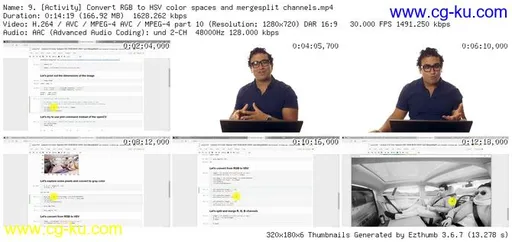HOT & NEW | Video: AVC 1280x720 | Audio: AAC 48KHz 2ch | Duration: 12.5 Hours | Lec: 92 | 7.36 GB | Genre: eLearning | Language: English | Sub: English
Learn OpenCV, Keras, object and lane detection, and traffic sign classification for self-driving cars
What you'll learn
Automatically detect lane markings in images
Detect cars and pedestrians using a trained classifier and with SVM
Classify traffic signs using Convolutional Neural Networks
Identify other vehicles in images using template matching
Build deep neural networks with Tensorflow and Keras
Analyze and visualize data with Numpy, Pandas, Matplotlib, and Seaborn
Process image data using OpenCV
Calibrate cameras in Python, correcting for distortion
Sharpen and blur images with convolution
Detect edges in images with Sobel, Laplace, and Canny
Transform images through translation, rotation, resizing, and perspective transform
Extract image features with HOG
Detect object corners with Harris
Classify data with machine learning techniques including regression, decision trees, Naive Bayes, and SVM
Classify data with artificial neural networks and deep learning
Requirements
Windows, Mac, or Linux PC with at least 3GB free disk space.
Some prior experience in programming.
Description
Autonomous Cars: Computer Vision and Deep Learning
The automotive industry is experiencing a paradigm shift from conventional, human-driven vehicles into self-driving, artificial intelligence-powered vehicles. Self-driving vehicles offer a safe, efficient, and cost effective solution that will dramatically redefine the future of human mobility. Self-driving cars are expected to save over half a million lives and generate enormous economic opportunities in excess of $1 trillion dollars by 2035. The automotive industry is on a billion-dollar quest to deploy the most technologically advanced vehicles on the road.
As the world advances towards a driverless future, the need for experienced engineers and researchers in this emerging new field has never been more crucial.
The purpose of this course is to provide students with knowledge of key aspects of design and development of self-driving vehicles. The course provides students with practical experience in various self-driving vehicles concepts such as machine learning and computer vision. Concepts such as lane detection, traffic sign classification, vehicle/object detection, artificial intelligence, and deep learning will be presented. The course is targeted towards students wanting to gain a fundamental understanding of self-driving vehicles control. Basic knowledge of programming is recommended. However, these topics will be extensively covered during early course lectures; therefore, the course has no prerequisites, and is open to any student with basic programming knowledge. Students who enroll in this self-driving car course will master driverless car technologies that are going to reshape the future of transportation.
Tools and algorithms we'll cover include:
OpenCV
Deep Learning and Artificial Neural Networks
Convolutional Neural Networks
Template matching
HOG feature extraction
SIFT, SURF, FAST, and ORB
Tensorflow and Keras
Linear regression and logistic regression
Decision Trees
Support Vector Machines
Naive Bayes
Who is the target audience?
Software engineers interested in learning the algorithms that power self-driving cars.


发布日期: 2019-10-07